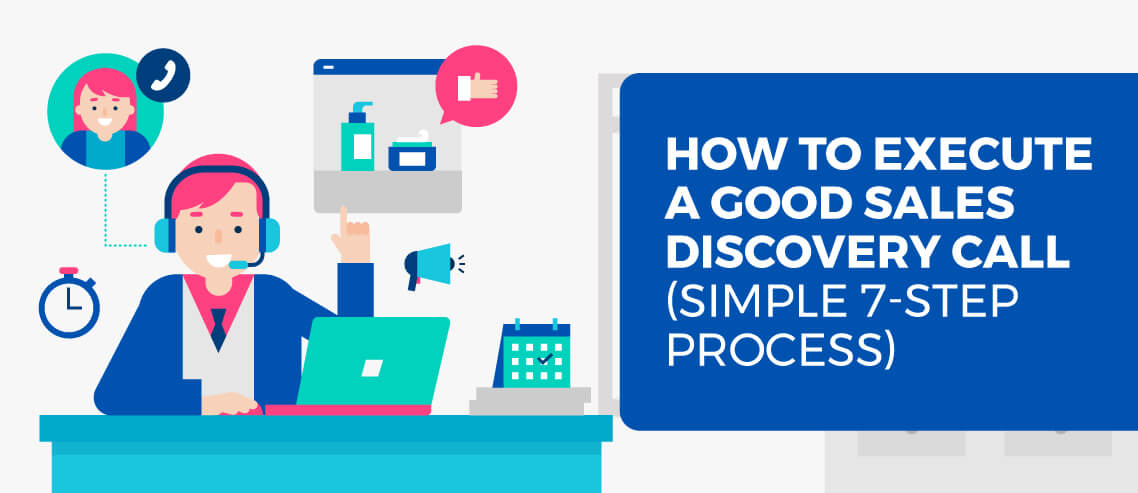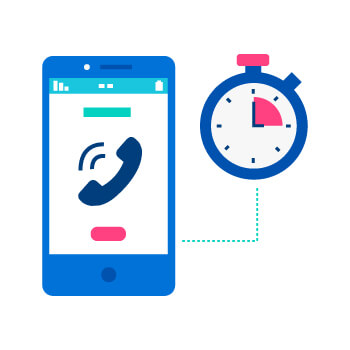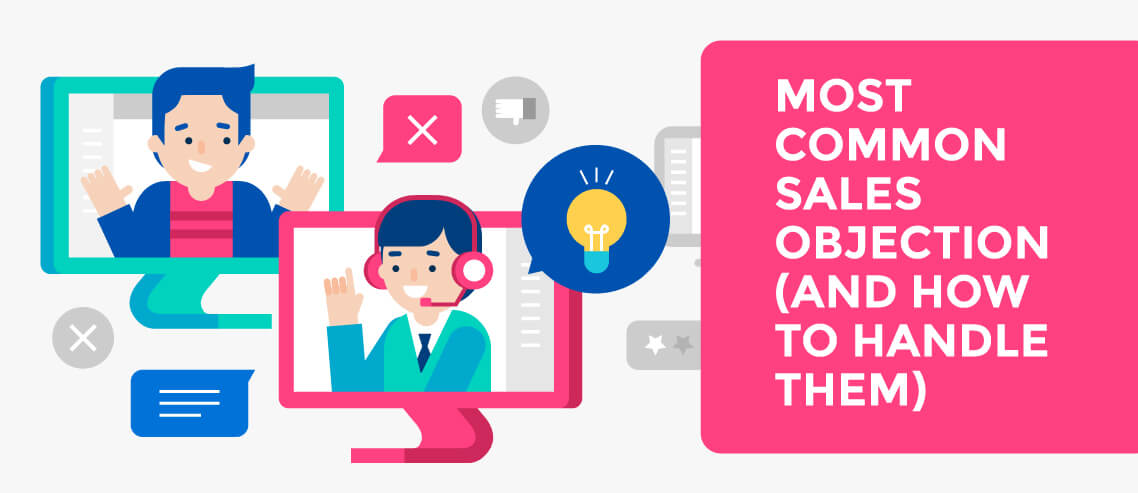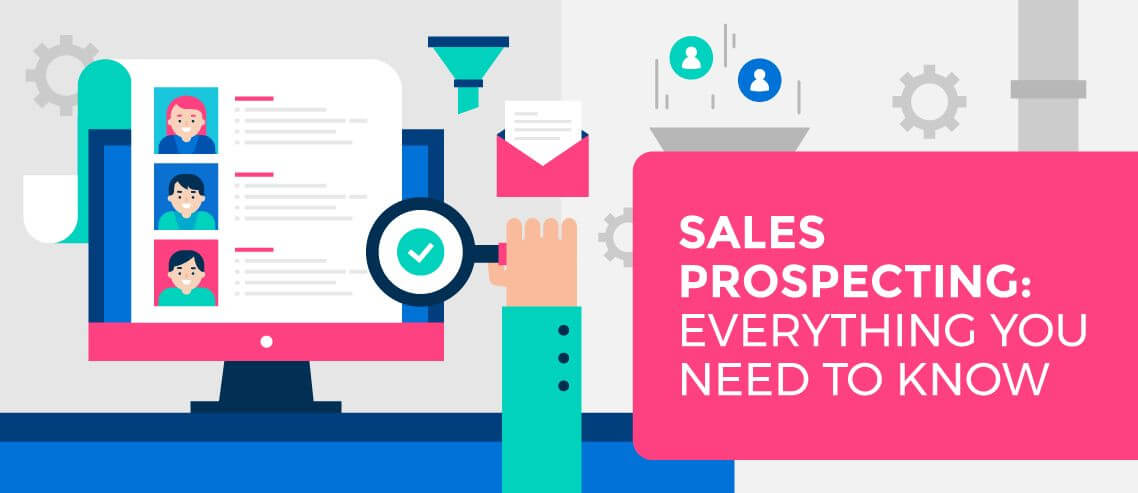How to Execute a Good Sales Discovery Call (Simple 7-Step Process)

Contents
Before we get into how to execute an effective discovery call, let’s answer one question.
What is a discovery call?
The goal of a discovery call is to either qualify a prospect (discover a sales opportunity), or disqualify them so as not to waste further time.
If you don’t bother to discover exactly what your prospects need, but continue to impart information on your products and services — and if you don’t practice closing qualified prospects on the call — then you’re likely to be wasting both your time and theirs.
Of course, once you’ve done that, it’s in your best interest to work towards closing the sale (or moving the sale forward) before you hang up the phone.
But time wasted on unqualified prospects adds up quickly, so it’s worth understanding how to properly execute a discovery call. Here’s what you need to know.
1. Sales Call Planning: Do Some Homework
For every prospect who schedules a call, you’ll need to know enough about them to hit the ground running and be as productive as possible in your discovery call together. Even for prospects who express interest but never schedule a call, it’s good to learn a bit about them since it might allow you to disqualify them as future prospects.
So how do you do that? When “doing your homework,” you’ll need to at least cover the basics — and it’s very simple.
The first thing to do is look them up on LinkedIn and study some details of what they’re about, including any current projects they’re working on.
In their profile, the prospect will likely tell you exactly what you need to know. For instance, if you’re a leadership coach looking for new customers, you should notice if your prospect is in a leadership position or is taking on a new role.
If they have no LinkedIn profile, give them a search on Google. It’s always a good idea to check out their personal website and what they’ve been doing the past 3–5 years.
You should also learn more specific things about them depending on why you’re wanting them as a customer. For instance, if you’re a literary agent inquiring about a book with them, then in addition to checking LinkedIn and Google, you should check Amazon to determine if they published any books already.
Ensure that your lead is qualified before the call. Discovery is about figuring out whether a lead is a good fit for your product or service. But for that to happen, you need to know what your ideal customer looks like, in concrete terms.
Make sure, before you go after a certain archetype of prospect, you know the answers to these 6 questions:
- Who do I want to work with?
- How big is the market? Is it big enough?
- What is their job title(s)?
- Where can I find them online or offline?
- Will they have a budget to work with me?
- Can we be successful together? Win-win results?
You’re in the business of selling solutions. It’s okay to say to yourself, “I can’t help this person.” That strengthens your pipeline and will keep you focused on the leads you can help. Disqualifying leads before furthering your relationship with them is just as important as qualifying leads; it will stop you wasting time on the wrong people.
Because there is so much relevant information about people online, limit your time doing homework on a prospect before a discovery call to only 5–15 minutes.
For some very forward-thinking tricks to help generate great prospects with fewer resources, you should read Hacking Sales: The Playbook for Building a High-Velocity Sales Machine, by Max Altschuler.
Remember: doing your homework doesn’t just mean scoping out prospects and working out how to win them over. It’s also a chance for you to review what it is you’re selling.
If you’re working through a long list of prospects and no one is qualifying for your product or service, the problem might not be them.
You need to make sure your product or service solves a common challenge or meets a frequent need within your market.
And if it doesn’t? Review and adjust, and then review again.
This is why it can be useful to take some time during the homework stage to write down the reasons prospects aren’t qualifying. If the same reason comes up again and again, take this to your product team or to a decision maker within your company. How would your product or service need to change to address this issue, and qualify those prospects?
Say you’re selling a traditional content marketing service, for instance, that offers blogs, features, infographics, videos, and SEO services. But when you login to LinkedIn, you notice a lot of potential prospects talking about influencer marketing – and they’re really excited about its potential.
The only problem is that your content marketing service doesn’t offer any influencer marketing products. In order to address this, you could qualify your list of prospects by hiring in some expert influencer marketers and positioning your brand as an authority within that area.
It may be that the issue you’re coming up against is something that can be more easily changed. Maybe your SaaS solution can’t be easily integrated with an innovative new tool that’s sweeping the market, so it’s become less attractive to prospects. This could be a very easy adjustment to make that instantly puts you back at the top of prospects’ lists.
Whatever the issue, don’t be afraid to take it to your business leaders – whether they make the necessary changes or not, they’ll thank you for your feedback – and you could find yourself with a much better product on your hands.
2. Have a Lot of Enthusiasm!

Ever heard that you should smile through the phone? It’s true.
Even if your prospects cannot see you, they can hear your expression. They can hear your smile.
But that’s just the start. From the very opening of a discovery phone call, you must bring excitement and enthusiasm to the conversation. If you’re not excited about potentially working together, that will come through. And if that’s the case, you should evaluate whether your prospecting strategy is effective enough.
Being enthusiastic also means being agreeable.
A small trick to use is mimicking, or repeating, their words or phrases on the call. This lets them know you’re listening, and it gets them reciprocating your behavior.
“I heard you say that you’re transitioning into a bigger role and that you’re looking to expand the team. That’s great! What impact has this had on your processes?”
Being enthusiastic is also about getting into a positive frame of mind. You can’t have a good discovery call if you’re not mentally prepared for it.
Have you ever scheduled a discovery call with a prospect right after you’ve had a company group lunch? It’s usually not the best idea because you’re exhausted.
No matter what else is going on in your life, you have to pump yourself up for a call to be able to control the tempo and conversation in a productive way. If you’re interested in learning some unique tricks about this, read Way of the Wolf, by Jordan Belfort.
3. Build Rapport Quickly
What’s most important on every discovery call is that you are personable. Have an attitude that even if you don’t make a sale, there’s a chance you can still find commonalities and work together in the future.
This helps build rapport instead of just getting down to business.
Ask questions about where they’re from or where they grew up. Mention a commonality you found in their LinkedIn profile. You both know the reason for the call is to eventually get down to business, but it’s good to break the ice first to ease the situation.
Ideally, you want to close every person you talk to, but prospecting is not a perfect tool.
You’ll have plenty of calls with people that are not an ideal fit. Discovery is as much to filter out those bad fits as it is to close a good fit. It’s during this process that you find the perfect customers.
As a sales rep, you should ask yourself, “Will us working together truly benefit them as a customer?” This idea that salespeople do best when they focus 100 percent on helping clients succeed is the focus of Let’s Get Real or Let’s Not Play, a book by Mahan Khalsa and Randy Illig.
After building some rapport, you will want to transition to the purpose of the call. But remember, you must maintain rapport to ensure you’re being personable enough to keep the conversation light.
Perhaps something like:
“So I reached out to you last week, and I’m curious to know your thoughts on our discussion so far in email. What do you think?”
4. Ask the Right Questions and Listen
Effective question-asking will help you discover more about the prospect and their goals. But from my point of view, if you’ve done your homework properly, you should already have a fairly complete picture of your prospect.
Asking the right questions allows you to control the conversation. It also ensures that you and the prospect both get value from what you talk about on the call. If your prospect starts going down a rabbit hole talking about their cousin’s wedding last weekend, then you need to reel it back in to stay on track.
Useful and productive answers ensure you discover their pain points and whether your service or product could provide a good solution in the shortest amount of time.
This is easier said than done. It’s also why having a script is so important. More on that later.
The point is, unless you’re listening actively, the prospect will be the one doing discovery.
In terms of time spent, sales reps should be talking less than 45% of the time in any discovery call. Prospects should be talking more than 55% of the time.
The Ideal Talk:Listen Ratio
Sales Rep: 45% of the sales discovery call
Lead: 55% of the sales discovery call
The more you listen, the more they’ll trust you. If you’re talking at your prospect non-stop on the call, it’s very unlikely they’ll take the next steps with you.
Managing your time effectively on a discovery call is a learned skill because both your questions and answers should be concise and professional.
It’s important when answering their questions to avoid explaining more than they ask for or be too relaxed in your tone. This can come off as you not being an expert. People most often want to buy from and work with experts. And it only takes one wrong answer to end a potential deal.
5. Set a Call Duration

Before you start a discovery call, establish the ideal amount of time for the call. It could be 15 minutes or it could be 1 hour.
The ideal time usually depends on the lifetime value of your average customer. If your LTV is <$1500, then you’ll likely only need a 15-minute discovery call. If your LTV is $5k–$15k, then 30–60 minutes is more appropriate.
For instance, if you’re a coach or professional, you might want to do an hour-long call if you start getting into assessments and start providing real value to the prospect in that first chat.
Ideal Length of a Sales Discovery Call
LTV < $1500 = 15 minutes
LTV $5000–15,000 = 30–60 minutes
Influencer coach Josh Steimle sums his discovery calls up like this:
“When I do discovery calls for coaching or in my mastermind, I take them through a 2-hour, 7 Systems of Influence audit to find out where they’re at currently in terms of what they want, and the assets they have that will help them get there.”
His clients often pay $10–15k for 6 months.
And enterprise sales can take even longer. When the LTV could be 6- or 7-figures, a discovery call could go a full day, and it’s likely to be followed up by more calls or personal meetings with additional people.
6. Follow a discovery call script
Hi, [name]. How are you doing? Thanks for scheduling a call with me on your book. I see you’re based in Buffalo, New York. Did you grow up there?
A script should be used as the foundation for your discovery calls and responses. Then as you get more confident, it can help you develop your own style.
A good script is mainly talking points, listed in the ideal order you need to talk about them. This ideal order is based on the sales process that’s most likely to close a deal or get to the next steps in the pipeline.
It should be based on prospects’ most commonly asked questions, and it should provide the rep clear answers that help them come off as an expert during the conversation.
This is key: The script must quickly establish the rep as an expert. How quickly and efficiently you’re able to answer common questions is the big tell here.
In addition to questions about your service or product, you also need to be familiar with the broader strokes of the industry you’re in. If the lead has questions about trends or a recent event, and you don’t have an answer, you’ll immediately lose points with the lead. And that may be the end of your sale right there.
Your script should include basic key milestones, like this:
Intros and rapport > pain points and similar experience >
the pitch > pricing > credible story or case study >
what are the next steps > follow up
In this example, you are trying to hit all of these milestones, or talking points. Once you hit one, you can then move on to the next.
Some people call this call mapping. The idea is to know in advance what your objective is and the route you need to take to get there.
For instance, if you’re satisfied that the lead has a pain point or two that your service or product can provide a solution for, then get to the pitch.
If the prospect then asks about pricing, that usually means they’re satisfied with your explanation, and you can move on to the next part.
If they ask about next steps, that means they are satisfied with pricing and your offer, and you can take steps to close the prospect into a customer.
7. Close the Deal
Being in sales requires savvy. It takes awareness to know when there is no sale and it’s time to stop chasing a prospect. But it also takes awareness to know when a prospect is making excuses to themselves and how to turn a No, no, no into a Yes, yes, yes.
For instance, some prospects love to engage but will tell me they are not a fit via email before we even get on the phone.
I tend to agree with them. If a prospect wants to close an opportunity before a discovery call, then they are likely not someone I want to work with. This happens sometimes with referrals.
On the flip side, if I reach out to someone personally because I would like to work with them and know they are my target customer, then I’m going to try every trick I know to overcome their objections and get that phone call.
You need to make judgment calls all the time.
Add-in the fact that it takes skills for persuasion once you do land the first phone call, and this whole thing can start to get complex.
The golden rule is that you should only attempt to close the sale if both you and your prospect are confident that working together is beneficial.
At this point, you have some rapport, and trust is building. Now we need to get a Yes.
That’s why having a clear discovery process is super important. It’s not about landing a big customer every time. It’s about consistency, and incrementally increasing the number of “yes nows” you receive.
Ask the prospect if you offer something they’d like to have/do with you. Their answer will be very telling. Remember, you’re in this together. And that should come across in every spoken word.
If you don’t want to be too direct, you can offer to send details of the next steps via email and establish when you will be in touch again. Then, schedule a follow-up call while you’re still on the phone.
If you get a next call scheduled, that shows very high intent from this prospect, and you can give them more attention in the final steps of the sales process.
If you receive a “yes, but later” then add them to your pipeline and follow up at a later time. Those will build and build until you can use your pipeline to close customers whenever you like.
Evaluating a Discovery Call

Completing a good discovery call is often the first step in closing a deal.
But there is still the possibility for a prospect who just finished a good discovery call to go cold. You must follow up often and hold them accountable from here on out.
You’re now their coach, which means they’ll follow your lead. If you don’t follow up for two weeks, neither will they.
To improve your discovery process, it’s vital to pay attention to the results you’re seeing. This will allow you to identify which techniques are working for you, and which you should drop.
Why is it so important to continually adapt and improve your process?
Your discovery process is crucial because it sets the pace for the rest of your sales process, determines rapport on phone calls, and greatly affects the results you get once you close them into a customer.
Symptoms of a weak discovery process include the customer backing out at the last minute asking you to clarify parts of the offer that should have been solidified weeks ago, or bad experience once you start working together.
Symptoms of a strong discovery process are of course results. Think about results from two perspectives:
- You meeting quota
- Success the customer achieves from working with you
But all sales reps are not created equal, and a strong discovery process is easily understood and implemented by an entire team to achieve even bigger results.
If your discovery process is effective, you’ll see multiple sales reps getting results from it. If your process is efficient, then you’ll see those results in less time.
You should be rigorously testing new strategies and channels to find great fits. Once you’re able to do that, your time spent on future prospects is automatically streamlined and shortened.
RELATED: How to Set Up a Winning Sales Cadence For Prospecting
In How to Be a Capitalist Without Any Capital, author Nathan Latka creates a pretty nice outline of his entire process in terms of inputs/outputs. This is the essence of good discovery.
Your goal is to figure out how to get one amazing high-quality customer (increase outputs) with as little time and work as possible (reduce inputs). And then repeat that 100x.
Inputs
- Prospects
- Emails
- Phone calls
- Support
- Me (Limit your “me” inputs to crank up your free time while still growing your output.)
Outputs
- Closed customers each month
- Earned revenue
- Bottoms up deals or up-sells
Stocks
- Commission (Shrink and grow based on how you dial up or down inputs and outputs.)
Feedback Loop Opportunities
- A prospect (input) starts an account, which I can up-sell (output), which increases revenue (output) as well as my commission (stock), and enables me to write a case study to obtain additional high-quality prospects (input) with less time in emails, calls, and support (inputs).
Since sales is as much about listening and connecting with people as it is influencing and persuading, I recommend one last book to help you in your sales journey and discovery calls, it’s called The Art of People: 11 Simple People Skills That Will Get You Everything You Want by Dave Kerpen.
Good luck!





